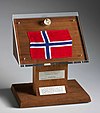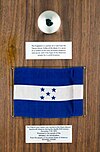Lunar sample displays

The lunar sample displays are two commemorative plaques consisting of small fragments of Moon specimen brought back by the astronauts of the Apollo 11 and Apollo 17 lunar missions. The plaques and Moon rocks were given as goodwill gifts in 1970 and 1973 to the people of 135 countries, the 50 states of the United States and some of its overseas territories, by United States President Richard Nixon.[1][2]
Description
[edit]Apollo 11
[edit]
The Apollo 11 lunar sample display is a commemorative podium style plaque display consisting of four rice-size dust particle specimens (dubbed "Moon rocks"), the recipient's flag and two small metal plates attached with descriptive messages.
In 1970, US president Richard Nixon gave presentation samples of Moon rock gathered by NASA astronauts Buzz Aldrin and Neil Armstrong, which had been flown from the Moon in the Apollo 11 lunar module Eagle and brought to Earth in the Apollo 11 command module Columbia, as gifts to 135 countries and 50 US states. [1]
Apollo 17
[edit]
The Apollo 17 lunar sample display consists of a Moon rock fragment from a lava Moon stone identified as lunar basalt 70017, the recipient's flag and two small metal plates attached with descriptive messages, all inside a wooden commemorative plaque.
Near the end of their third and final moonwalk, and what would be the last moonwalk of the Apollo program, Apollo 17 astronauts Eugene Cernan and Harrison Schmitt "picked up a very significant rock, typical of what we have here in the valley of Taurus-Littrow... composed of many fragments, of many sizes, and many shapes, probably from all parts of the Moon, perhaps billions of years old" and made a special dedication to the young people of Earth. This rock was later labeled sample 70017.[3] Nixon ordered the distribution of fragments of the rock to 135 foreign heads of state and the 50 U.S. states. These gifts were distributed in 1973. [2]
Recipients
[edit]Inside the United States, displays were given to all 50 states and four territories: American Samoa, Guam, Northern Mariana Islands and Puerto Rico.
Outside the United States, the following countries received displays:
Afghanistan, Albania, Algeria, Andorra, Argentina, Australia, Austria, Barbados, Belgium, Bhutan, Bolivia, Botswana, Brazil, Bulgaria, Burma, Burundi, Cameroon, Canada, Cambodia, Central African Republic, Ceylon (current Sri Lanka), Chad, Chile, China, Colombia, Congo (Brazzaville), Congo (Kinshasa), Costa Rica, Cuba, Cyprus, Czechoslovakia, Dahomey, Denmark, Dominican Republic, Ecuador, Egypt, El Salvador, Equatorial Guinea, Eswatini, Ethiopia, Finland, France, Gabon, Gambia, Ghana, Greece, Guatemala, Guinea, Guyana, Haiti, Honduras, Hungary, Iceland, India, Indonesia, Ivory Coast, Iran, Iraq, Ireland, Israel, Italy, Jamaica, Japan, Jordan, Kenya, Kuwait, Laos, Lebanon, Lesotho, Liberia, Libya, Liechtenstein, Luxembourg, Madagascar, Malawi, Malaysia, Maldives, Mali, Malta, Mauritania, Mauritius, Mexico, Monaco, Mongolia, Morocco, Muscat and Oman, Nauru, Nepal, Netherlands, New Zealand, Nicaragua, Niger, Nigeria, Norway, Pakistan, Panama, Paraguay, Peru, Philippines, Poland, Portugal, Romania, Rwanda, San Marino, Saudi Arabia, Senegal, Sierra Leone, Singapore, Somalia, South Africa, South Korea, Southern Yemen, Soviet Union, Spain, Sudan, Sweden, Switzerland, Syria, Taiwan, Tanzania, Thailand, Togo, Trinidad and Tobago, Tunisia, Turkey, Uganda, United Kingdom, Upper Volta (current Burkina Faso), Uruguay, Vatican City, Venezuela, South Vietnam, West Germany, Western Samoa, Yemen, Yugoslavia and Zambia. [1][2]
Also, displays were given to the United Nations.
Bahamas, Bahrain, Bangladesh, Fiji, Solomon Islands (in that time a British overseas possession), Mozambique (in that time an overseas province of Portugal), Qatar, Tonga and United Arab Emirates didn't receive display of Apollo 11, but they received display of Apollo 17. [2]
Stolen and missing
[edit]Of the 270 Moon rocks given to countries by the Nixon administration, approximately 180 are missing. Many that are not have been locked away in storage for decades. Their locations have been sought or tracked by researchers and hobbyists because of their rarity and the difficulty of obtaining more. They have also been stolen and forged.[citation needed]
See also
[edit]References
[edit]- ^ a b c Pearlman, Robert (1999–2012). "Where today are the Apollo 11 goodwill lunar sample displays?". collectspace.com. Retrieved March 24, 2015.
- ^ a b c d Pearlman, Robert (1999–2012). "Where today are the Apollo 17 goodwill lunar sample displays". collectspace.com. Retrieved March 24, 2015.
- ^ Astromaterials Research & Exploration Science. "70017 Ilmenite Basalt" (PDF). NASA.
- Apollo program lunar sample displays
- Petrology
- United States–European relations
- United States–Central American relations
- United States–South American relations
- United States–African relations
- United States–Asian relations
- United States–Caribbean relations
- United States–Middle Eastern relations
- United States–North American relations
- United States–Oceanian relations
- Diplomatic gifts

